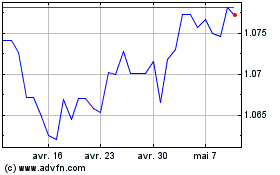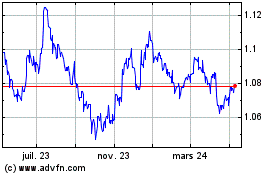Euro Mixed After Eurozone GDP Data
07 Décembre 2018 - 7:29AM
RTTF2
The euro was trading mixed against its major counterparts in the
early European session on Friday, after the release of Eurozone
gross domestic product data for the third quarter, which showed
slowest pace of growth in four years, matching preliminary
estimate.
Data from Eurostat showed that Eurozone GDP rose 0.2 percent in
the third quarter after rising 0.4 percent in the previous three
months. The reading matched flash estimate.
On a year-on-year basis, the GDP growth was revised down to 1.6
percent following a 2.2 percent rise in the second quarter. The
reading was originally reported as 1.7 percent.
Separate data showed that employment growth for the euro area
has been confirmed in the third quarter.
Eurozone employment increased by 0.2 percent in the third
quarter following a 0.4 percent rise in the preceding quarter.
The economy expanded 1.3 percent annually after logging a 1.5
percent growth in the second quarter.
European stocks bounced back after sharp losses the previous day
following the arrest of chief financial officer of Chinese tech
giant Huawei.
Investors drew some comfort from a firm dollar and a late Wall
Street recovery overnight, helped by hopes that the U.S. Federal
Reserve could pause its interest-rate hikes.
The focus remained on a key U.S jobs report due tonight, with
economists expecting employment to increase by 205,000 jobs in
November after an increase of 250,000 jobs in October. The jobless
rate is expected to hold at 3.7 percent.
The currency showed mixed trading against its major opponents in
the Asian session. While it rose against the pound and the yen, it
held steady against the franc and the greenback.
The euro advanced to a 2-day high of 128.44 against the yen and
held steady thereafter. The pair was valued at 128.14 when it ended
deals on Thursday.
Data from the Ministry of Internal Affairs and Communications
showed that Japan household spending fell 0.3 percent on year in
October, coming in at 290,396 yen.
That missed expectations for an increase of 1.1 percent
following the 1.6 percent decline in September.
The single currency pulled back to 1.1363 against the greenback,
from a high of 1.1383 seen at 3:45 am ET. The euro is likely to
find support around the 1.12 level.
Having climbed to a 2-day high of 0.8931 against the pound at
4:00 am ET, the euro reversed direction and retreated to 0.8902
following the data. The euro is seen finding support around the
0.88 area.
Survey data from the Bank of England showed that UK inflation
expectations for the coming year rose to their highest level in
five years.
Median expectations of the rate of inflation over the coming
year were 3.2 percent, compared to 3.0 percent in August.
The euro reversed from an early low of 1.1284 against the franc,
rising to 1.1303. If the euro rises further, 1.16 is possibly seen
as its next resistance level.
Looking ahead, U.S. and Canadian jobs data for November,
University of Michigan's preliminary consumer sentiment index for
December, U.S. wholesale inventories and consumer credit for
October are scheduled for release in the New York session.
At 12:00 pm ET, Federal Reserve Governor Lael Brainard will
speak about financial stability at the Peterson Institute in
Washington DC.
Euro vs US Dollar (FX:EURUSD)
Graphique Historique de la Devise
De Mar 2024 à Avr 2024

Euro vs US Dollar (FX:EURUSD)
Graphique Historique de la Devise
De Avr 2023 à Avr 2024
